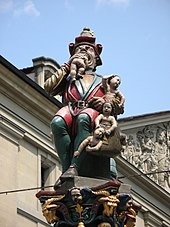Ogre

An ogre (feminine: ogress) is a large, cruel, monstrous and hideous humanoid monster, featured in mythology, folklore and fiction. Ogres are often depicted in fairy tales and folklore as feeding on human beings, and have appeared in many classic works of literature. In art, ogres are often depicted with a large head, abundant hair and beard, a voracious appetite, and a strong body. The term is often applied in a metaphorical sense to disgusting persons who exploit, brutalize or devour their victims. Closely related is the troll figure, although these are sometimes not as malevolent.
Etymology

T (or from the Greek river god Oiagros, father of Orpheus).
The word ogre came into wider usage in the works of Charles Perrault (1628-1703) or Marie-Catherine Jumelle de Berneville, Comtesse d' Aulnoy (1650-1705), both of whom were French authors. Other sources say that the name is derived from the word Hongrois, which means Hungarian. All these words may derive from a shared Indo-European mythological concept (as Tolkien himself speculated, as cited by Tom Shippey, The Road to Middle-earth, 45). Some see the French myth of the ogre as being inspired by the real-life crimes of Gilles de Rais.[1]
The first appearance of the word ogre in Perrault's work occurred in his Histoires ou Contes du temps Passé (1697). It later appeared in several of his other fairy tales, many of which were based on the Neapolitan tales of Basile. The first example of a female ogre being referred to as an ogress is found in his version of Sleeping Beauty, where it is spelled ogresse. The Comtesse d' Aulnoy first employed the word ogre in her story L'Orangier et l' Abeille (1698), and was the first to use the word ogree to refer to the creature's offspring.
Ogres in modern fiction
One of the most famous ogres in pop culture is the character Shrek.

Ogres in modern games
Ogres appear in many popular fantasy roleplaying and video games series. See also Ogre (disambiguation).
See also
References
- Rose, Carol. Giants, Monsters, & Dragons: An Encyclopedia of Folklore, Legend, and Myth. New York: W. W. Norton & Company, 2001. ISBN 0-393-32211-4
- Shippey, Tom. The Road to Middle-earth. London: HarperCollins, 1992 (rev.). ISBN 0-261-10275-3
- South, Malcom, ed. Mythical and Fabulous Creatures: A Source Book and Research Guide. Westport, CT: Greenwood Press, 1987. Reprint, New York: Peter Bedrick Books, 1988. ISBN 0-87226-208-1
- "Ogre." Encyclopædia Britannica. 2006. Encyclopædia Britannica Online. 15 May 2006 <http://www.search.eb.com/eb/article-9125639>
Notes
- ^ www.hérésie.com
